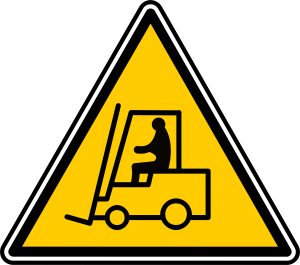Thinking of getting an employee certified as a forklift operator?
Here are some things you should know before you begin the process.
According to the Occupational Safety and Health Association (OSHA), about 70% of all lift truck incidents in the US can be avoided with appropriate implementation of safety training. The most common of these incidents include forklifts being driven off loading docks, forklifts falling between docks and trailers, workers being struck by forklifts, or workers falling off of elevated pallets or forks. Other dangers include improper use of forklift jacks. In light of all of these dangers, the best way to keep yourself and your employees safe is to train competent operators and make sure that your equipment and forklifts are functioning properly.
Keep in mind that it is federal law that no person below the age of 18 ever operate or ride on a forklift truck. In addition, no person, even above the age of 18, may operate a lift truck who is not properly trained and certified to do so.
Q: How do I train a forklift operator?
A: To become certified, an employee must first be trained. OSHA
requires employers to create and use a training program that makes use of both formal training (video, lecture, presentation, etc.) and practical training (demonstration and exercises in the forklift).
Q: How often must I re-evaluate my forklift operators?
A: At least once every three years.
Q: What must a valid forklift operator training program include?
A: Training programs can be either purchased or developed by the employer, but a valid program must cover the following topics, paraphrased directly from OSHA regulation:
• Operating instructions and warnings for the types of truck the operator will be authorized to operate.
• Differences between a lift truck and an automobile.
• Truck controls and instrumentation: where they are located, what they do, and how they work.
• Engine or motor operation, steering and maneuvering, and load manipulation, stacking, and unstacking.
• Visibility (including restrictions due to loading).
• Fork and attachment adaptation, operation, and use limitations, as well as composition of loads to be carried and load stability.
• Vehicle capacity and stability, especially on ramps and other sloped surfaces.
• Inspection and maintenance that the operator will be required to perform.
• Refueling and/or charging and recharging of batteries.
• Surface conditions where the vehicle will be operated.
• Pedestrian traffic in areas where the vehicle will be operated.
• Restricted places and hazardous locations where the vehicle will be operated.
Employees still in training may not operate a forklift unless under the direct supervision of a certified operator. If a certified operator uses a lift truck in an unsafe way or is involved in an accident with a lift truck, he or she may be subject to a suspended certification and a session of refresher training before he or she may operate a lift truck again.
Q: How can I get a trained operator certified?
A: A certification in accordance with OSHA standards includes the name of the operator, the date of his or her training and evaluation, and the name of the person (or people) performing the training and evaluation. In order to receive certification, employees must show adequate mastery of the training topics listed above.
Again, training/certification programs can either be purchased or developed by an employer. In order for an employer to develop his or her own program, he or she must first take an OSHA trainer course that provides certification as a trainer. For more information on these and other regulations, see the sources below.
http://www.indtrk.org/training
https://www.osha.gov/SLTC/poweredindustrialtrucks/index.html
https://www.osha.gov/SLTC/etools/pit/assistance/index.html#training


